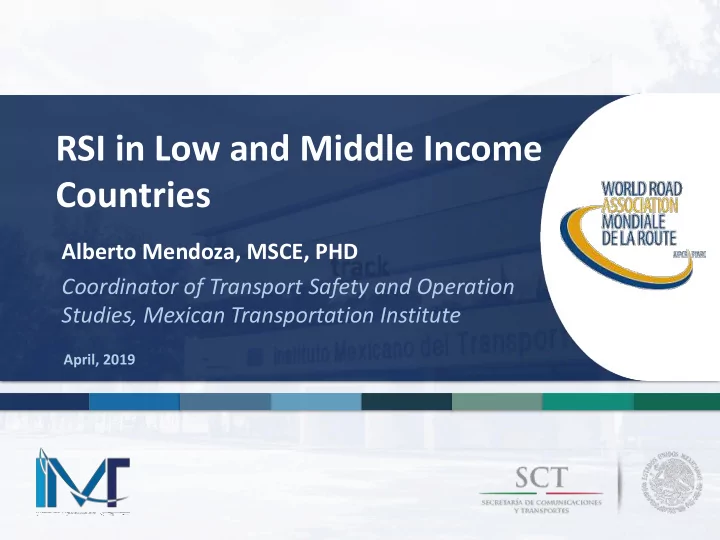

RSI in Low and Middle Income Countries Alberto Mendoza, MSCE, PHD Coordinator of Transport Safety and Operation Studies, Mexican Transportation Institute April, 2019
RSA and RSI in LMIC and Latin America In recent years, LMIC have placed emphasis on improving the road safety of infrastructure, given that the type of actions required are usually effective and are received with acceptance by users. Traditionally, the corrective approach of identifying and treating "black spots" has been applied. In recent years, preventive approaches have been added, such as the RSA and RSI, primarily the latter.
RSA and RSI in LMIC and Latin America The main experiences in this area to date have been: ✓ Conducting RSI using the traditional method based on "checklists" and field inspections. ✓ The incorporation of specialized equipment. ✓ The incorporation of the collection and analysis of detailed information on the geometry of the road section. ✓ The global evaluation of the network to generate multiannual programs aimed at improving it, taking each section to its most convenient condition.
RSI using the traditional method An example is the RSI carried out in 2008 on 800 km motorways concessioned to IDEAL. The methodology included: ✓ Compilation of baseline information. ✓ Review and evaluation of baseline information. ✓ Field inspection by day and night trips in both directions. ✓ Analysis of the information gathered during the inspection. ✓ Generation of the RSI report.
RSI using the traditional method Among the priority actions carried out is the installation of SOS poles.
Incorporation of specialized equipment Automated equipment has been incorporated which, when circulating along the section to be evaluated, allows information to be obtained from the road and measurements to be taken without interrupting daily traffic or affecting its speed of operation, for example: ✓ Equipment Hawkeye 2000 or similar. It has a series of aligned cameras that record images every 10 m, as well as odometer, GPS, etc. Allows detailed reviews and measurements at the office. ✓ AMAC (Advanced Mobile Asset Collection) dynamic auscultation system. It allows to evaluate the current physical condition of the vertical and horizontal signage, and to measure its dimensions, position, height, placement angle, color, luminance and retroreflectivity.
Incorporation of specialized equipment
Incorporation of specialized equipment
Detailed road geometry information It has been obtained from LiDAR flights over the section, which makes it possible to restore the cartography and road geometry, and analyze it against geometric design standards and recommendations of RSA and RSI using computer programs developed for that purpose, allowing the identification of risks and the generation of improvement measures. This information is georeferenced. In general, the improvements arising from this analysis are of considerable scope and cost (e.g. correction of alignment, curves, superelevation rates, cross section, intersections, drainage), so they are usually medium and long term.
Detailed road geometry information
Global evaluation of the network In 2012, the road safety evaluation of 46 thousand kilometers of Federal Highways in Mexico was carried out using the iRAP methodology and in 2013 the evaluation of 19 thousand additional kilometers of state jurisdiction (secondary highways). Based on this information, the characteristics of the road are rated in office for more than 60 variables (width of lanes, shoulders, whether the roadway is divided or not, median type, lateral severity, condition of signs and markings, pavement, etc.), which allow estimating the risk of the infrastructure by 100 m segments, based on a scale of 1 to 5 stars, where 5 corresponds to the best safety conditions and 1 to the worst. This is done for four types of users: vehicle passengers, pedestrians, cyclists and motorcyclists.
Global evaluation of the network
Other interesting cases ✓ Pátzcuaro – Lázaro Cárdenas Concessioned Highway.
Other interesting cases ✓ Pátzcuaro – Lázaro Cárdenas Concessioned Highway. • Sections with overtaking lane
Other interesting cases ✓ Autopista Concesionada Pátzcuaro – Lázaro Cárdenas. • Roadside advertising campaign
Other interesting cases ✓ Autopista Urbana Norte - Viaducto Elevado Bicentenario
Other interesting cases ✓ Autopista Urbana Norte - Viaducto Elevado Bicentenario
Other interesting cases ✓ Autopista Urbana Norte - Viaducto Elevado Bicentenario
Other interesting cases ✓ Autopista Urbana Norte - Viaducto Elevado Bicentenario
Other advances ✓ Several countries have developed their own Manual for conducting RSA and RSI. Only Costa Rica has regulations that oblige their execution. In general, RSA and RSI have not been officially instituted. ✓ With regard to the decision to carry them out, this generally falls on the administrations in charge of planning, construction and operation of roads. There is also interest on the part of road concessionaires. ✓ There is great interest and work is being done on the profile, training and certification of auditors and inspectors. ✓ Work is starting on RSA at the project stages.
Conclusions ✓ The depth of the RSA and RSI has depended on the needs of the client (expressed in the "Brief") ✓ Of all the concerns and recommendations that have arisen, the client is the one who ultimately decides which ones will be adopted. ✓ The best measures are those that solve the problems at their root and are affordable. ✓ It is essential to select auditors/inspectors with validated training and experience. ✓ Confidentiality is indispensable in the work of RSA and RSI. ✓ The use of existing road accident statistics may help.
TRANSPORT SAFETY AND OPERATION +52 442 216 9777 ext. 2014/2015 mendoza@imt.mx/ www.imt.mx
/Instituto Mexicano del @IMT_mx IMTMexico Transporte
Recommend
More recommend